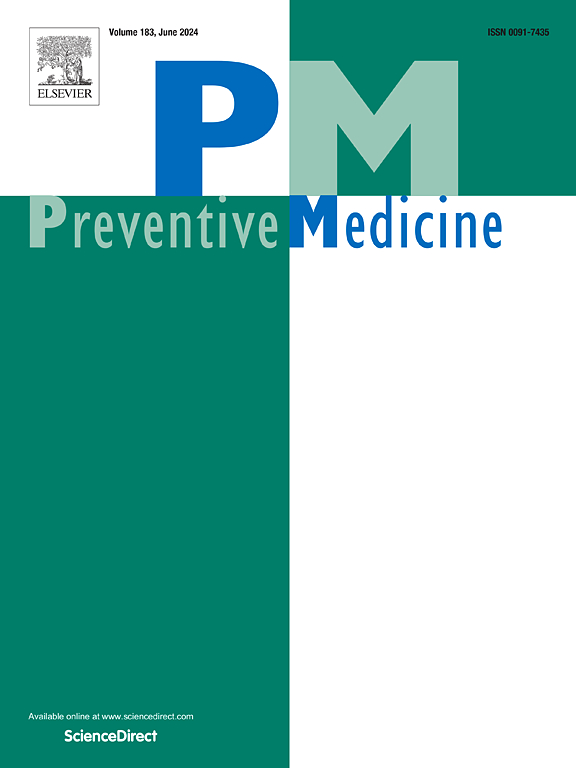净化空气:在 21 个国家的便利抽样调查中,对二手大麻烟雾危害的高度认识与不在家中吸食大麻有关。
IF 4.3
2区 医学
Q1 MEDICINE, GENERAL & INTERNAL
引用次数: 0
摘要
目的:随着各国采取更加宽松的大麻使用政策,人们对二手大麻烟雾(SHCS)暴露危害的认识正在下降,而且大多数大麻吸烟都是在家中进行的。我们量化了所报告的在家吸食大麻与二手大麻烟雾(SHCS)暴露危害感知之间的关系:分析样本包括来自 21 个国家的 28,154 名成年受访者,他们是年度横截面全球药物调查(2021 年)的合法或非法药物使用者。受访者报告了对暴露于 SHCS 对非吸烟居民造成危害的感知,以及过去 30 天内任何人在家中吸食大麻的情况。逻辑回归估算了经协变因素调整的家庭内吸食大麻(是/否)的几率比和 95 % 置信区间。此外,还按居住国量化了危害感知与在家中吸食大麻之间的关联:61%的人报告在过去 30 天内没有在家中吸食大麻;按 10 分制计算,对接触 SHCS 危害的平均感知为 5.2。危害感知处于第 75 百分位数(与第 25 百分位数相比)的人不在家中吸食大麻的几率要高出 70%(OR = 1.7,95 % CI = 1.6-1.8)。在所有居住国中,对危害感知较高的人报告未在家中吸食大麻的几率较高,但并非所有国家都具有显著的统计学意义。瑞典(OR = 3.9,95 % CI = 1.5-11.9)和新西兰(OR = 2.3,95 % CI = 2.0-2.7)的相关性最强:认为吸食大麻有害的受访者在家中吸食大麻的可能性较低。如果这种关联随后被证明是因果关系,那么提高对吸入有害健康物质相关危害的认识将大大减少住宅中的大麻二手烟暴露。本文章由计算机程序翻译,如有差异,请以英文原文为准。
Clearing the air: Heightened perception of harm from secondhand cannabis smoke exposure is associated with no in-home cannabis smoking in a 21-country convenience sample
Objective
As countries adopt more lenient cannabis use policies, perception of harm from secondhand cannabis smoke (SHCS) exposure is decreasing and most cannabis smoking is taking place at home. We quantified the relationship of reported in-home cannabis smoking with perceived harm from SHCS exposure.
Methods
The analytic sample comprised 28,154 adult respondents, from 21 countries, to the annual cross-sectional Global Drug Survey (2021) of users of licit or illicit drugs. Respondents reported perception of harm to non-smoking residents from SHCS exposure and past 30-day cannabis smoking in the home by anyone. Logistic regression estimated covariate-adjusted odds ratios and 95 % confidence intervals of in-home cannabis smoking (yes/no). The association between harm perception and in-home cannabis smoking by country of residence was also quantified.
Results
Sixty-one percent reported no in-home cannabis smoking in the last 30 days; mean perception of harm of SHCS exposure on a 10-point scale was 5.2. Those at the 75th (vs 25th) percentile of perceived harm had 70 % higher odds (OR = 1.7, 95 % CI = 1.6–1.8) of no in-home cannabis smoking. In all countries of residence, higher perception of harm was associated with reporting no in-home cannabis smoking, although not all were statistically significant. The strongest association was seen in Sweden (OR = 3.9, 95 % CI = 1.5–11.9) and New Zealand (OR = 2.3, 95 % CI = 2.0–2.7).
Conclusions
Respondents who perceived SHCS as harmful were less likely to report in-home cannabis smoking. If this association subsequently proves causal, increasing awareness of the harms associated with SHCS exposure could substantially reduce residential cannabis secondhand smoke exposure.
求助全文
通过发布文献求助,成功后即可免费获取论文全文。
去求助
来源期刊

Preventive medicine
医学-公共卫生、环境卫生与职业卫生
CiteScore
7.70
自引率
3.90%
发文量
0
审稿时长
42 days
期刊介绍:
Founded in 1972 by Ernst Wynder, Preventive Medicine is an international scholarly journal that provides prompt publication of original articles on the science and practice of disease prevention, health promotion, and public health policymaking. Preventive Medicine aims to reward innovation. It will favor insightful observational studies, thoughtful explorations of health data, unsuspected new angles for existing hypotheses, robust randomized controlled trials, and impartial systematic reviews. Preventive Medicine''s ultimate goal is to publish research that will have an impact on the work of practitioners of disease prevention and health promotion, as well as of related disciplines.
 求助内容:
求助内容: 应助结果提醒方式:
应助结果提醒方式:


